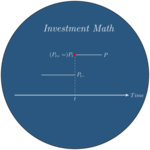Integrating Returns
This post takes another stab at return compounding, when price trajectories potentially are of infinite variation. Starting from first principles, it shows that the differential equation followed by the price can either be a standard differential equation or a stochastic differential equation. The key concept is the quadratic variation of trajectories.
Discretization
I assume we are given a financial instrument with strictly positive price history \((P_{t})_{t \geq 0}\) which provides no income. I also assume we have a set of grids indexed by \(\delta\) and such that \(t^{\delta}_{k}=k\delta\), \(k \geq 0\). \(1/\delta\) can be any strictly positive natural number \(n\)1. As this natural number grows, the grid gets finer. I concentrate on the log-price \((\log(P_{t}))_{t \geq 0}\) and the corresponding log-returns. Consider now the change in the log-price from \(0\) to \(N\) (\(N\) years), choosing \(K^{\delta}\) such that \(t^{\delta}_{K^{\delta}}=N\): \[\log(P_{N})-\log(P_{0})=\sum_{k=0}^{K^{\delta}-1} \log(P_{t^{\delta}_{k+1}})-\log(P_{t^{\delta}_{k}})=\sum_{k=0}^{K^{\delta}-1} \log(P_{t^{\delta}_{k+1}}/P_{t^{\delta}_{k}})\] \[=\sum_{k=0}^{K^{\delta}-1} \log(1+R_{\delta,t^{\delta}_{k+1}}),\] where \(R_{\delta,t^{\delta}_{k+1}}\) is the return: \[\frac{P_{t^{\delta}_{k+1}}-P_{t^{\delta}_{k}}}{P_{t^{\delta}_{k}}}\] over the time interval \([t^{\delta}_{k},t^{\delta}_{k+1}]\). I consider a taylor expansion of order \(2\) of the log: \[\log(1+R)=R-\frac{1}{2}R^{2}.\] We get: \[\log(P_{N})-\log(P_{0})\approx\sum_{k=0}^{K^{\delta}-1} R_{\delta,t^{\delta}_{k+1}}-\frac{1}{2}\sum_{k=0}^{K^{\delta}-1} R^{2}_{\delta,t^{\delta}_{k+1}}.\]
Does the quadratic variation matter?
Two very different cases now show up:
for ordinary price functions (namely functions of finite variations), the quadratic term goes to zero as the grid is refined. One can hope to get the following integral equation in the limit:\[\log(P_{N})-\log(P_{0})=\int_{0}^{N} \frac{dP_{u}}{P_{u}}.\] The integral is of the Stieltjes type. This corresponds to an ordinary differential equation: \[d(\log(P_{t}))=\frac{dP_{t}}{P_{t}}.\]
for price functions driven by diffusions, the quadratic term is non zero (and of finite variations) and the integral representation is more complex: \[\log(P_{N})-\log(P_{0})=\int_{0}^{N} \frac{dP_{u}}{P_{u}}-\frac{1}{2}\int_{0}^{N}d[R]_{u},\] where \(d[R]\) is the measure corresponding to the quadratic term. This leads to a stochastic differential equation: \[d(\log(P_{t}))=\frac{dP_{t}}{P_{t}}-\frac{1}{2}d[R]_{t}.\] The first integral above cannot be given a pathwise definition. It is a stochastic (Ito) integral. The second integral is of the more common Lebesgue-Stieltjes type and depends on the volatility of the return process. In this more general context, the log-return and the standard return do not match.
The functions we encounter in college calculus are of finite variation and have zero quadratic variation. The definition of the Brownian motion (and the by-product, diffusions) forces to consider functions of infinite variation and finite strictly positive quadratic variations. In short, such functions can have wild fluctuations over short periods of time. In the case of the Brownian motion, fluctuations over a time interval \(\delta\) is of the order of magnitude \(\delta^{1/2}\) while functions of finite variations over the same time interval have fluctuations of the order of magnitude \(\delta\). This is much (infinitely) smaller! Such functions are ‘much more predictable’ than the Brownian motion. In practice, a cash account is a good example of such a well behaved return process. Equity prices are more likely described by diffusions, although the best model might be of a more general type, allowing for jumps (cf. Levy processes).
Summary
Whether a given price process is better described as a finite variation function or as generated by a diffusion is an empirical matter. Diffusions allow much bigger surprises over short periods of time and have wilder fluctuations. From a mathematical perspective, they are more complex objects, requiring a special integration theory (and thus a special theory of differential equations). Whereas in the standard calculus context, over infinitesimal intervals, standard returns and log-returns coincide, they do not in the diffusion context. In the latter case, log-returns are lower than standard returns, being affected by a negative convexity bias that depends on return volatility.
The description in this note takes the perspective of a given return history, a given path. The underlying probabilistic structure is swept under the rug. This is adequate in the finite variation case as the integral (or equivalently the differential equation) can be described without knowledge of the probabilistic structure. In the diffusion case however, integration becomes a truly probabilistic operation. The full mathematical theory is much more complex (we won’t try to develop it, but we will use the theorems). The purpose of the note was to emphasize that in the end, if the paths of prices are very noisy (wild), standard calculus does not hold, and in particular, log-returns and the standard returns do not match even for arbitrarily small time scales.
Links
In this way, integer times are covered by all grids.↩︎
